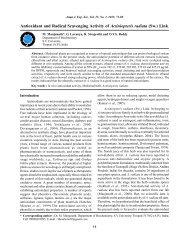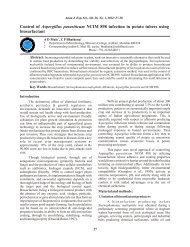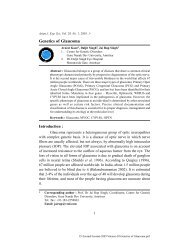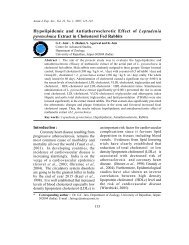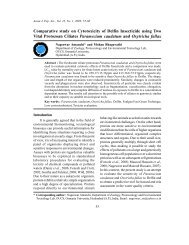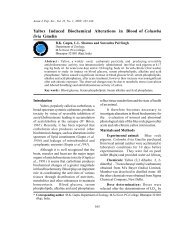Master file
Master file
Master file
Create successful ePaper yourself
Turn your PDF publications into a flip-book with our unique Google optimized e-Paper software.
Asian J. Exp. Sci., Vol. 22, No. 3, 2008; 307-310<br />
Study on Phenolics and Their Oxidative Enzyme in Capsicum annuum<br />
L Infected with Geminivirus<br />
Rishi Kesh Meena*, Vidya Patni and D.K. Arora<br />
Plant Pathology, Tissue Culture and Biotechnology Laboratory,<br />
Department of Botany,<br />
University of Rajasthan, Jaipur-302004 (Raj.); India<br />
Abstract : The contents of total phenol, o-dihydroxyphenol, peroxidase and poly phenoloxidase<br />
were recorded in healthy and diseased leaf of chilli. The total phenols were found to be higher<br />
in diseased leaves as compared to those of healthy leaves where as lower o-dihydroxy phenols<br />
were recorded. Enhanced peroxidase activity and polyphenol oxidase activities found to occur<br />
in diseased leaves as compared to healthy leaves.<br />
Key words : Capsicum annuum, total phenol, o-dihydroxyphenol, polyphenol oxidase,<br />
peroxidase, chilli leaf curl disease.<br />
Introduction<br />
Chilli (Capsicum annuum L) is an<br />
important spice crop in India and ranks first<br />
among all the spice with a share of 33.7% in<br />
the total production (Anonymous 2003).The<br />
crop is infected by several fungal, bacterial and<br />
viral diseases. Among all the viral diseases leaf<br />
curl disease greatly affect the crop productivity<br />
of chilli. The disease is characterized by<br />
severe adaxial and abaxial curling of the leaves,<br />
shrinking of the leaves and stunted plant<br />
growth. This is accompanied by puckering<br />
and swelling of veins and the buds are<br />
stimulated to produce cluster of leaves. The<br />
whole plant assumes a bushy appearance with<br />
stunted growth, fewer flowers and fruits<br />
developed due to disease (Ansari et al., 2006).<br />
Peroxidase catalyses the oxidation of various<br />
hydrogen donors in the presence of H O and<br />
2 2<br />
oxidized the phenolics substance. Their reaction<br />
products were highly reactive and toxic to<br />
pathogens. They played important role in host<br />
parasite interaction, disease development and<br />
defence reaction of infected plants. The<br />
enhanced phenol synthesis and peroxidase<br />
activity in various host parasite combination<br />
307<br />
was correlated with disease resistance (Ghosal<br />
et al, 2004). Hence, present study is an attempt<br />
on investigation on the changes in phenols (total<br />
and o-dihydroxy phenols) and enzymes like<br />
peroxidase and poly phenol oxidase due to the<br />
infection of geminivirus.<br />
Materials and Methods<br />
Healthy and diseased leaves of chilli were<br />
collected. Estimation of Phenolics and their<br />
oxidative enzymes in diseased and healthy<br />
leaves was carried out by standard methods.<br />
Bray and Thorpe (1954) method was used for<br />
estimation of total phenol, Worthington Enzyme<br />
Manual (1972) for Peroxidase activity, Shinshi<br />
and Noguchi (1975) for Polyphenol oxidase.<br />
For the estimation 500mg of healthy and<br />
diseased leaves were taken. Total phenols were<br />
estimated and O.D. was recorded at 725 nm.<br />
O-dihydroxy phenol was estimated by<br />
Bhattacharya and Chenchaiah (2007) method<br />
and O.D. was recorded at 515 nm. Total<br />
phenols were calculated with the help of<br />
standard curve prepared using catechol.<br />
Isozymes of peroxidase (E.C. 1.11.1.7) were<br />
analysed by polyacrylamide gel<br />
* Corresponding author : Rishi Kesh Meena, Department of Botany, University of Rajasthan, Jaipur<br />
(Raj.); India; E-mail : rishi_1180@yahoo.com
Meena R.K. et al. (2008) Asian J. Exp. Sci., 22(3), 307-310<br />
electrophoresis,PAGE (Davis 1964). PAGE<br />
was prepared and samples were prepared by<br />
homogenizing 1g of diseased and healthy leaf<br />
in 5 ml phosphate buffer pH=7, 0.1 M.<br />
Samples were poured in wells of running gel<br />
by micropipette. The gel tray was placed on<br />
buffer electrode filled upto 2 cm depth.<br />
Peroxidase was incubated in equal volume of<br />
acetate buffer (pH =4.8, 1 M) and 0.1% odianisidine<br />
for one hour and enzyme bands<br />
were visualized under 5 Mm solution of H 2 O 2<br />
and guaicol after inoculation. The gels were<br />
photographed and Rm values of each band<br />
were calculated by making zymograms.<br />
Results and Discussion<br />
Total phenol was significantly high in<br />
diseased leaf as compared to healthy leaf<br />
(Fig.1) The increased quantity of total phenol<br />
might be attributed to defence mechanism. The<br />
resistance to disease caused by pathogen was<br />
attributed to the presence of high amount of<br />
phenol (Jain and Yadav, 2003; Kushawaha and<br />
Narain, 2005 and Parashar and Lodha, 2007).<br />
Hence, the increased quantity of phenolics in<br />
the infected plant parts of the chilli may be<br />
contributing to the resistance against pathogen<br />
(viral infection).<br />
Phenolics compounds play an important<br />
role in the defence mechanism of the plant and<br />
this is supported by their accumulation in the<br />
cell followed by viral infection. Increased level<br />
of phenolic suggested an acceleration of<br />
phenols synthesizing pathway following<br />
pathogen infection. The increase in the phenols<br />
in severely infected plant parts could be<br />
attributed to the induced resistance for further<br />
invasion by the pathogen. Hence, the increase<br />
in phenolics in relation to resistance was<br />
reported in Brassica (Singh; 2004). Activation<br />
of PAL and subsequent increase in phenol<br />
contents were general responses associated<br />
with resistance mechanism in plants as reported<br />
(Ghosal et al,2004 ).<br />
Higher peroxidase activity was observed<br />
in diseased leaf as compared to healthy leaf<br />
308<br />
(Fig.3). Devanathan et al (2005) observed high<br />
peroxidase activity in bunchy top Banana virus<br />
infected cultivars of banana. Increased<br />
peroxidase activity was associated with<br />
resistance reaction which could be due to<br />
increased phenol concentration, where phenols<br />
were cofactor of peroxidase and hence<br />
influenced resistance in the host. Polyphenol<br />
oxidase was responsible for oxidation of odihydroxy<br />
phenols. In the present study high<br />
polyphenol activity was observed (Fig. 4) and<br />
lower O-dihydroxy phenol in diseased leaf as<br />
compared to healthy (Fig. 2). which was<br />
responsible for phenol accumulation as<br />
oxidation of o-dihydroxy phenol was due to this<br />
enzyme<br />
Enzymes involed in phenol metabolism<br />
were most easily considered as one of the<br />
important biochemical parameters for disease<br />
resistance. Polyphenol oxidases catalyses the<br />
oxidation of monophenol and o-dihydroxy<br />
phenol. Polyphenol oxidase was known as<br />
tyrosinase, catechol oxidase and potato oxidase<br />
(Maheshwari et al, 2006). The enhanced<br />
polyphenol acivity might result in the augmented<br />
rate of oxidation of phenolics substance that<br />
participates in the defence reaction of host.<br />
These reactive quinones were known to inhibit<br />
polyphenol oxidase. Table-1 shows Rm values<br />
of isoperoxidase bands as is evident from<br />
diagrammatic sketch of peroxidase banding<br />
patterns (Fig. 5A,B). The electrophoretic<br />
studies revealed three isoperoxidase bands in<br />
diseased leaves whereas two in healthy leaves.<br />
The Rm values in diseased leaves were 0.22,<br />
0.46 and 0.87 whereas in healthy ones 0.25<br />
and 0.46. Rm values. 0.46 was similar in<br />
healthy and diseased leaf. Intensity of<br />
peroxidase acivity was found to be very high<br />
in diseased leaf as compared to that of healthy<br />
leaf.<br />
Acknowledgement<br />
The first author (Rishikesh Meena) is<br />
highly thankful to CSIR, New Delhi for giving<br />
Senior Research Fellowship.
Study on Phenolics and Their Oxidative Enzyme in Capsicum annuum L Infected with Geminivirus<br />
Table 1 : Rm value of isozymes of peroxidase activity of healthy and diseased leaf of chilli analysed by<br />
PAGE<br />
Healthy leaf Diseased leaf<br />
0.25 0.22<br />
0.46 0.46<br />
- 0.87<br />
Fig. 1 : Estimation of total phenols in healthy and<br />
diseased leaf<br />
Fig. 3 : Estimation of peroxidase activity in<br />
healthy and diseased leaf<br />
309<br />
Fig. 2 : Estimation of O-dihydroxyphenol in<br />
healthy and diseased leaf<br />
Fig. 4 : Estimation of polyphenol-oxidase activity<br />
in healthy and diseased leaf
Meena R.K. et al. (2008) Asian J. Exp. Sci., 22(3), 307-310<br />
Fig. 5 A : Banding pattern of Peroxidase isozyme<br />
by PAGE B Zymogram of isozyme pro<strong>file</strong><br />
References<br />
Anonymous (2003): Economics Survey of India<br />
(2002-03) Ministry of Finance and Company<br />
Affairs Economics Division, Indian. pp.245.<br />
Ansari N.A., Mishra V.N. and Tiwari J.P. (2006): Host<br />
range of tomato leaf curl virus. Ann. Pl. Protec.<br />
Sci., 14, 509-510.<br />
Bhattacharya A.K. and Chenchaiah K.C. (2007): Seed<br />
coat phenolic compound of red gram Cajanus<br />
cajan as chemical barrier in formulation of<br />
artificial diet of Spodoptera litura. Ann. Pl.<br />
Protec. Sci., 15, 92-96.<br />
310<br />
Bray H.C. and Thorpe W.V. (1954): Analysis of<br />
phenolic compounds of interest in metabolism.<br />
Meth. Biochem. Analysis. 1, 27-52.<br />
Devanathan M., Ramaiah M., Sundar A.R. and<br />
Murugan M.(2005): Changes of peroxidase and<br />
polyphenol oxidase in bunchy top nana virus<br />
infected and healthy cultivars of banana. Annals<br />
of Plant Physiology. 19, 114-116<br />
Davis B.J. (1964): Disc electrophoresis II. Method<br />
and application to human proteins. Ann. N.Y.<br />
Acad. Sci. 121, 404<br />
Ghosal T.K., Dutta S., Senapati S.K. and Deb D.C.<br />
(2004): Role of phenol contents in legume seeds<br />
and its effect on the biology of Collosbrchus<br />
chinensis. Ann. Pl. Protec. Sci.12, 442-444.<br />
Jain A.K. and Yadav H.S. (2003): Biochemical<br />
constituents of finger millet genotype<br />
associated with resistant to blast caused by<br />
Pyricularis grisea. Ann. Pl. Protec. Sci.,11, 70-<br />
74.<br />
Kushwaha K.P.S. and Udit Narain (2005):<br />
Biochemical changes to pigeon pea leaves<br />
infected with Alternaria tenuissinia. Ann. Pl.<br />
Protec. Sci.,13, 415-417.<br />
Maheshwari M.U., Suresh S. and Emmanual N.<br />
(2006): Biochemical basis of resistance in rice<br />
hybrids and conventional varities against<br />
brown plant hopper. Ann. Pl. Protec. Sci., 14,<br />
69-72.<br />
Parashar A. and Lodha P. (2007) : Phenolics<br />
estimation in foeniculum vulgare infected with<br />
Ramularia blight. Ann. Pl. Protec. Sci. 15, 396-<br />
398.<br />
Shinshi H. and Noguchi M. (1975): Relationship<br />
between peroxidase, IAA-oxidase and<br />
polyphenol oxidase. Phytochemistry. 14, 1255-<br />
1258.<br />
Singh H.V. (2004): Biochemical transformation in<br />
Brassica spp. due to Peronospora parsitica<br />
infection. Ann. Pl. Protec. Sci., 12, 301-304.<br />
Worthington-Enzyme Manual (1972): Enzymes,<br />
Enzyme Reagents, related Biochemicals,<br />
Worthington Corporation Freehold, New Jersey,<br />
U.S.A. pp. 216.



